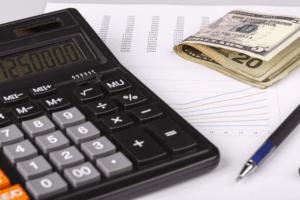Content
- Sum of the Years’ Digits Depreciation Method
- Calculating the Double Declining Depreciation Method
- How To Calculate Double Declining Balance Depreciation
- How to Calculate Depreciation Methods
- Example of DDB Depreciation
- Double-Declining Balance (DDB) Depreciation Formula
- From the course: Excel: Financial Functions in Depth

We can understand how the depreciation expense is calculated each year under the double-declining method from the below schedule. For example, last year, the actual depreciation expense as per the depreciation rate should have been $13,422 but kept at $12,108.86 to keep the asset at its estimated salvage value. So, the depreciation expense is calculated in the last year by deducting the salvage value from the opening book value. If something unforeseen happens down the line—a slow year, a sudden increase in expenses—you may wish you’d stuck to good old straight line depreciation. While double declining balance has its money-up-front appeal, that means your tax bill goes up in the future.

In order to do that, we need to figure out what deprecation amount we should take from the last four years of the truck’s useful life. We can calculate that by subtracting the salvage value ($5,000) from the book value at the end of year six ($12,464.27). With this method, you can determine that the depreciation expense will be $6,666.67 after 12 years, and what the car will likely be worth after 12 years.
Sum of the Years’ Digits Depreciation Method
Once you fully depreciate the asset’s value, you have to record the salvage value of the asset and close the account. However, a new business brings the responsibility of managing the fundamental and technical aspects of marketing, finance, etc. You will have to learn about the intricacies and functioning of these key divisions that will drive your company’s growth. Download thisaccounting examplein excel to help calculate your own Double Declining Depreciation problems. With this method, the depreciation is expressed by the total number of units produced vs. the total number of units that the asset can produce. Conceptually, depreciation is the reduction in the value of an asset over time due to elements such as wear and tear. Eric is a staff writer at Fit Small Business focusing on accounting content.
Depreciation rates used in the declining balance method could be 150%, 200% , or 250% of the straight-line rate. When the depreciation rate for the declining balance method is set as a multiple, doubling the straight-line rate, the declining balance method is effectively the double-declining balance method. Over the depreciation process, the double depreciation rate remains constant and is applied to the reducing book value each depreciation period. The book value, or depreciation base, of an asset, declines over time. The double-declining balance method is an accelerated depreciation calculation used in business accounting.
Calculating the Double Declining Depreciation Method
In this tutorial we discuss the most popular accelerated method called Double-declining balance. In Straight-line depreciation, the depreciable cost remains the same each year, and the same percentage of the cost is depreciated each year.
Depreciation enables companies to generate revenue from their assets while only charging a fraction of the cost of the asset in use each year. As a business owner, you need to know that the transition from one accounting method to another is inevitable. You should ask your accountant about their approach to calculating the value of depreciation for different assets. Here’s everything you need to know about depreciation and the double-declining balance method of depreciation used by most organizations in the US. As you can see, the depreciation rate is multiplied by the asset book value every year to compute the deprecation expense.
How To Calculate Double Declining Balance Depreciation
Like straight-line depreciation use a consistent rate of depreciation for each year of an asset’s lifespan, accelerated depreciation methods like DBB show a steep drop in the first years of the asset’s life. After this, there will be increasingly smaller depreciation expenses recorded over the later years of the lifespan.
- It takes into consideration the time value of money to determine the cost of the asset over its useful life.
- It has never been more important for companies to understand the importance of ESG and put in place policies and practices that will ensure their success.
- Other variants of the declining balance method increase the straight-line depreciation rate by different factors.
- It depreciates a tangible asset using twice the straight-line depreciation rate.
- Double declining depreciation is helpful for businesses that want to recognize expenses upfront to save taxes.
It’s important to know the current condition of the asset, so you can determine its Double Declining Balance Method value. Consider the asset’s age and whether it still functions as intended.
How to Calculate Depreciation Methods
This method is more realistic as an asset’s value falls drastically with a slight change in the technological environment. The amount of depreciation is calculated on the asset’s present value, unlike other methods that consider its historical value.

Instead of evaluating an asset’s value evenly from one year to the next, the double-declining depreciation method evaluates an asset’s value by doubling the amount of its depreciation in its first few years. Depending on the type of asset, there are several reasons to choose this method. In this article, we discuss what double-declining balance is, when to use this method and how to calculate it with an example to show how it works. The double-declining balance method calculates depreciation using 200% of the straight-line depreciation rate.
Example of DDB Depreciation
Remember, every accounting term is going to stay a little hazy until you work through a couple examples. So, we’ll complete an example here—complete with full ten-year depreciation. This method is used for assets that typically lose most of their value early. Eric Gerard Ruiz is an accounting and bookkeeping expert for Fit Small Business. He completed a Bachelor of Science degree in Accountancy at Silliman University in Dumaguete City, Philippines. Before joining FSB, Eric has worked as a freelance content writer with various digital marketing agencies in Australia, the United States, and the Philippines.

As a hypothetical example, suppose a business purchased a $30,000 delivery truck, which was expected to last for 10 years. After 10 years, it would be worth $3,000, its salvage value. Under the straight-line depreciation method, the company would deduct $2,700 per year for 10 years–that is, $30,000 minus $3,000, divided by 10. Depreciation https://www.bookstime.com/ rate in the double-declining balance can be calculated by using the straight-line to multiply with the 2. Net book value can be calculated by using the cost of fixed asst deducting its accumulated depreciation. The main reason why dividends are so attractive is due to the fact that they are expected to grow over time.
Double-Declining Balance (DDB) Depreciation Formula
He spends most of his time researching and studying to give the best answer to everyone. A trained CPA, Brian uses his skills to make sure each of his client businesses receives the financial management it needs. Stop Calculating depreciation in the year after the depreciable cost falls below the salvage value of the vehicle. Which translates to depreciation of $400 per year for the company’s van.
What is an example of a balloon payment?
Example of a Balloon Loan
Let's say a person takes out a $200,000 mortgage with a seven-year term and a 4.5% interest rate. Their monthly payment for seven years is $1,013. At the end of the seven-year term, they owe a $175,066 balloon payment.
Because you’re subtracting a different amount every year, you can’t simply repeat the same calculation each year, as you can with the straight-line method. As mentioned earlier, this approach is particularly useful for property whose value will decrease rapidly after you acquire it. Companies generally use a declining balance method or a straight-line method to calculate the value of depreciation of an asset. The double-declining approach has gained much popularity recently and is also known as the accelerated depreciation method or the reducing balance method.
For more than 200 years businesses have trusted The Hartford. We can help you get the right coverage with an online quote.
Another benefit is that this method may not be as sensitive to errors in using depreciation methods like the sum-of-years digits method. For instance, if you make an annual cash flow of $200/month, the first month your car is given for free. The second month you’ll have a negative cash flow of (-$200). In this case, consider the first month as being +$200 and the second month being -$200.
The straight-line method
So, if your bank account had $100 last year but doesn’t have $102 this year something should be wrong. This means an extra two dollars were taken out of your account, which makes sense because of inflation. After calculating the DDBD for the first year, they are able to calculate the depreciation over the vehicle’s useful life.
- The best way to explain the double-declining method of depreciation is to look at some simple examples.
- We also reference original research from other reputable publishers where appropriate.
- This method provides a more accurate rate of depreciation than other methods because it takes into consideration the time value of money which is an important part of sustainable accounting practises.
- The following table illustrates double declining depreciation totals for the truck.
Acceleration means you are initially covering more “ground” over a shorter period of time. However, you still can’t depreciate an asset to a value less than its salvage value with the hard limit of zero. For the math to work out, the double declining balance method depreciates more than the straight line method early on.
For specific assets, the newer they are, the faster they depreciate in value. As these assets age, their depreciation rates slow over time. In these situations, the declining balance method tends to be more accurate than the straight-line method at reflecting book value each year. In this article, we define the double-declining balance method, explain its uses and effects, demonstrate how to calculate it and identify other common depreciation methods.


Recent Comments